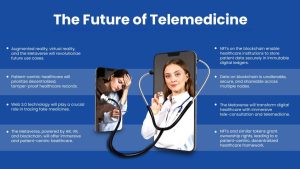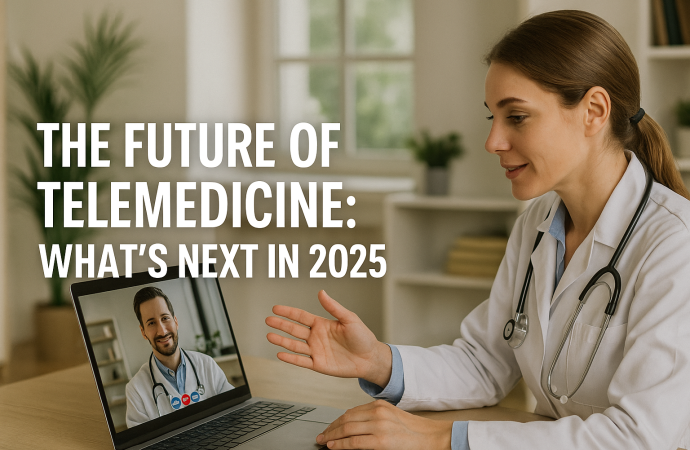Introduction Telemedicine is changing healthcare. It allows people to receive medical care without leaving their homes. By 2025, e-medicine will be even more advanced. With the help of AI, 5G, and personalized healthcare, it will offer even better services. In this article, we will look at how e-medicine will change in 2025 and how these
Introduction
Telemedicine is changing healthcare. It allows people to receive medical care without leaving their homes. By 2025, e-medicine will be even more advanced. With the help of AI, 5G, and personalized healthcare, it will offer even better services.
In this article, we will look at how e-medicine will change in 2025 and how these changes will make healthcare medical services better for everyone.
What Is Telemedicine?

Image by: Yandex.com
Telemedicine lets patients talk to doctors and healthcare providers using video calls, phone calls, and other digital tools. It has become a key part of the healthcare system because it’s easy, convenient, and efficient. While e-medicine grew quickly during the COVID-19 pandemic, its full potential to is still unfolding.
By 2025, United States e-medicine will be even more advanced and connected. New technologies like artificial intelligence (AI), 5G networks, and health apps will make healthcare even better. These innovations will help doctors provide better care, make individual patient healthcare easier to access, save patient electronic health records, and reduce costs.
Benefits of Telemedicine

Image by: Yandex.com
Telemedicine offers several important benefits. First, it makes healthcare more accessible, especially for social workers who live in rural areas or places with fewer healthcare facilities. Patients no longer have to travel long distances to see a doctor; they can now consult with healthcare professionals from the comfort of their homes. This also saves time, as patients can avoid long waiting times at clinics or hospitals. Additionally, e-medicine can be more cost-effective by reducing the need for in-person visits and lowering healthcare costs. For doctors, e-medicine makes it easier to manage patient schedules and provide timely care, ensuring they can meet the needs of their patients more efficiently.
The Role of Telemedicine in Healthcare

Image by: Yandex.com
Telemedicine is a key part of modern healthcare services. It gives patients a simple and fast way to get medical advice and treatment. By using e-medicine, traditional primary care healthcare systems don’t get as crowded, allowing doctors and nurses to help more patients without feeling overwhelmed. E-medicine is also very important for managing long-term illnesses, providing mental health support, and offering follow-up care. With video calls, remote monitoring, and secure messaging, doctors and nurses can stay connected with patients, keep track of their health coaching, and provide ongoing care to improve patients’ health outcomes.
The Future of Telemedicine in 2025

Image by: Yandex.com
1. AI in Telemedicine: Smarter Healthcare
What Is AI in Telemedicine?
AI (Artificial Intelligence) is technology that can learn and make decisions. In e-medicine, AI helps doctors diagnose diseases faster by analyzing data like medical history and patient symptoms.
Why Is AI Important for Telemedicine?
AI can:
- Help doctors find problems quickly, making diagnoses faster.
- Automate simple tasks, like scheduling appointments or managing patient records, so doctors can focus on their patients.
- Offer personalized treatment plans based on the patient’s specific health needs.
How Will AI Help in 2025?
By 2025, AI will:
- Help doctors analyze medical images (like X-rays) faster and more accurately.
- Provide personalized advice to patients based on their health data.
- Monitor patients remotely and suggest changes to their treatment when needed.
2. 5G: Faster Telemedicine
What Is 5G?
5G is the latest mobile network that is faster and more reliable than 4G. It helps e-medicine because it allows data to be sent very quickly.
Why 5G Is Important for Telemedicine
With 5G, e-medicine will become faster and smoother. Here’s how:
- Video calls with doctors will be clearer, with no delays.
- Health data from wearables (like smartwatches) will be sent instantly to doctors, making monitoring easier.
- Remote surgeries will be possible because 5G provides the speed needed for doctors to guide robotic surgeries from anywhere.
How Will 5G Improve Telemedicine in 2025?
- 5G will make it easier to connect with doctors from anywhere in the world.
- Real-time health data will allow doctors to react faster to changes in a patient’s condition.
3. Personalized Healthcare: More Tailored Care
What Is Personalized Healthcare?
Personalized health care services means treatment that is customized for each individual. In 2025, e-medicine will use health data to create treatment plans that are just right for each person.
Why Is Personalized Healthcare Important?
Personalized healthcare is better because it takes into account the person’s unique health needs. This can lead to better health systems outcomes and fewer side effects.
How Will Personalized Healthcare Work in 2025?
- Doctors will use AI and big data to track health trends and offer better care.
- E-medicine apps will help patients track their health statuses in real-time, allowing doctors to adjust treatments as needed.
4. Niche Telemedicine Services: Specialized Care for Everyone
What Are Niche Telemedicine Services?
Niche e-medicine services focus on specific areas of healthcare, like mental health or skin care. These services will become more popular in 2025, offering patients specialized care from home.
Why Are Niche Services Important?
Specialized care can be hard to find, especially in remote areas. Niche e-medicine services allow patients to get the care they need without having to travel.
Examples of Niche Telemedicine Services:
- Telehealth for mental health: Virtual therapy for patients dealing with anxiety or depression.
- Teledermatology: Seeing a dermatologist through a video call for skin problems.
- Telephysical therapy: Remote rehabilitation for people recovering from surgery or injury.
5. Virtual Reality (VR) and Augmented Reality (AR) in Telemedicine
What Are VR and AR?
Virtual Reality (VR) creates a completely digital world, while Augmented Reality (AR) adds digital elements to the real world. In e-medicine, these technologies can help doctors heath care team to treat patients and train healthcare workers.
How Will VR and AR Be Used in Telemedicine?
- VR will help doctors practice surgeries or treatments in a safe, virtual space.
- AR will assist doctors during remote surgeries by providing digital guides on the patient’s body.
How Will VR and AR Help in 2025?
- VR will allow doctors to practice complex procedures before doing them on real patients.
- AR will make it easier for doctors to perform remote surgeries with the help of real-time digital tools.
Comparative Table: How Technologies Will Improve Telemedicine in 2025
| Technology | Benefits | Impact on Telemedicine |
|---|---|---|
| AI | Faster diagnosis, better treatment plans | Helps doctors provide personalized care and monitor patients remotely |
| 5G | Faster, reliable connections | Enables high-quality video calls and instant data transmission for remote monitoring |
| Personalized Healthcare | Custom treatment based on patient data | Provides personalized care plans tailored to each patient’s needs |
| Niche Services | Specialized care for mental health, skin care, etc. | Offers remote consultations for specific health needs |
| VR & AR | Immersive experiences for doctors and patients | Improves remote surgeries, therapy, and training opportunities |
Conclusion
Telemedicine is changing fast, and 2025 will bring even more exciting innovations. AI, 5G, and personalized healthcare will make e-medicine faster, smarter, and more tailored to each patient. As these technologies continue to develop, healthcare will become more accessible and efficient for everyone, no matter where they are.
The future of e-medicine is bright, and it’s coming soon. Keep an eye on these innovations to stay informed about how healthcare is evolving in 2025.
Call to Action
Are you ready to experience the future of e-medicine? Stay updated with the latest innovations and learn how AI and 5G networks are improving healthcare. Visit our site to learn more about these advancements and how they will benefit you in 2025!
















